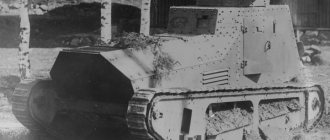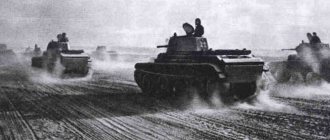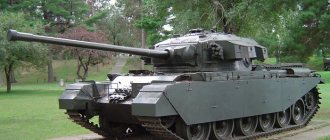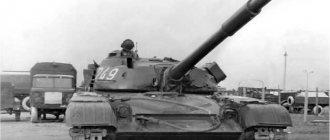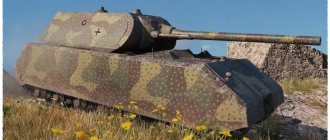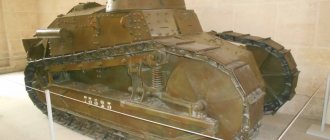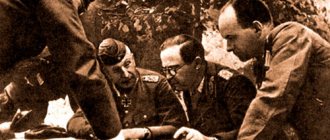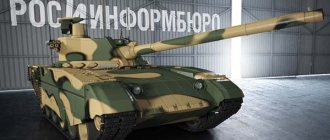Definition 1
A flamethrower tank is a combat vehicle whose main weapon is a flamethrower.
The main purpose of a flamethrower tank is to support infantry when storming enemy positions. Flamethrower tanks are usually created on the basis of regular production tanks by installing a flamethrower instead of the main or auxiliary armament.
On the eve of World War II, the USSR had a significant number of chemical tanks, but their personnel consisted almost entirely of obsolete vehicles using the T-26 chassis. Work was underway to install flamethrowers on tanks that were modern for that time. In 1939, development began on the A-32 flamethrower tank, which later became the prototype of the T-34. The outbreak of war and the evacuation of enterprises delayed the start of production of the tank, but at the beginning of 1942, serial production of the OT-34 began, which became the most massive Soviet serial flamethrower tank of the Patriotic War.
Are you an expert in this subject area? We invite you to become the author of the Directory Working Conditions
German flamethrower tanks
Definition 2
Flammpanzer III is a German flamethrower tank.
In October 1942, the Armament Service decided to produce 100 flamethrower tanks based on the Pz.III. MIAG transferred 100 vehicles of modification M to Wegmann AG for conversion into flamethrowers. The company had experience in such work when converting Pz.II tanks and French B1bis tanks. In the Pz tower. Instead of cannon III, a steel pipe was installed - a protective casing for the flamethrower barrel. The operating pressure was 15 MPa, created using a DKW auxiliary engine. Before firing, two tanks with 100 liters of fire mixture were heated for 5 minutes with hot water from the cooling system. The fire mixture consumption allowed for 125 one-second shots with a firing range of up to 55 m.
Auxiliary weapons - MG 34 machine guns - were preserved in their original places. Their ammunition capacity was 3,750 rounds. The tank crew consisted of three people - a commander (flamethrower gunner), a driver mechanic and a radio operator gunner. The order for the production of tanks was completed by the spring of 1943, and they were sent to the Eastern Front.
Finished works on a similar topic
Course work: Competition between Soviet and German tank designers. Flamethrower tanks 440 ₽ Abstract Competition between Soviet and German tank designers. Flamethrower tanks 250 ₽ Test competition between Soviet and German tank designers. Flamethrower tanks 200 ₽
Receive completed work or specialist advice on your educational project Find out the cost
Definition 3
Flamm.Pz.B2 is a Wehrmacht modification of the French Char B1 heavy tank.
The modifications were limited to installing a 75-mm flamethrower howitzer in place. A booth for the flamethrower with an aiming device was built above the flamethrower. Since there was no room in the tank for a tank with a fire mixture, it was installed at the stern, sheathing the tank with 30 mm armor. Compressed air cylinders were in the fighting compartment. The flamethrower was powered by a two-stroke motorcycle engine. Another feature of the flamethrower version was the transfer of the radio station F antenna to the starboard side. In this way, 60 vehicles were modernized. By June 1941, 24 tanks were completed and became part of the 102nd Flamethrower Tank Battalion. After a month of fighting, two vehicles were irretrievably lost. The rest were modernized.
Yuri Pasholok. Flamethrower baby in German
Home » Real story » History of Wars » Yuri Pasholok. Flamethrower baby in German
History of WarBooks on the history of tanks
byakin 12/27/2021 570 0 comments
14
in Favoritesin Favoritesfrom Favorites 8
Yuri Pasholok. Flamethrower baby in German
History of the flamethrower tank Pz.Kpfw.II(F), which is periodically called Flammpanzer II, or Flamingo
From the outside, the history of German tank building may seem quite logical and simple. By 1937, the German army had 4 models of tanks. The first of them was the Pz.Kpfw.I, created under the impression of British “patrol” tanks (also ripped off from a Carden-Loyd tractor, essentially a variation of the chassis of that same patrol tank). The second was the Pz.Kpfw.II, close in weight and purpose to the Vickers Mk.E, however, the Germans decided to make the turret single-seat, and instead of a 37-47 mm caliber gun they installed a 20-mm automatic gun. To be fair, at that time many people installed 20-mm machine guns (or even something lighter) in such machines. The third tank was the Pz.Kpfw.III, a typical medium tank with a 37 mm cannon. Finally, the fourth was the Pz.Kpfw.IV, a support tank with a 75 mm short-barreled gun. True, if you start to figure out how the Germans got two light and two medium tanks, various funny details begin to emerge. And if you start digging even deeper, even more fun will come out.
One of the first Pz.Kpfw.II (F). Despite the rapid preparation of the first sample, the conversion of conventional tanks into flamethrower tanks began only in 1940
This kind of fun was enough for the Pz.Kpfw.II. Starting with the fact that the tank appeared as a result of Krupp's inability to fit a 20 mm cannon and 3 crew members onto the Kleinetraktor (future Pz.Kpfw.I) chassis. Therefore, a project for a 6-ton tank appeared, which quickly reached a mass of 7.5 tons, and then the tendency to overeating only increased. At the same time, the 6th Department of the Armament Department made a mistake by imposing a suspension similar to the Pz.Kpfw.I. It was unsuccessful, and as a result MAN spent a lot of effort to make the Pz.Kpfw.II a reliable tank. This was successful, but by that time Heinrich Kniepkamp had started work on the La.S.138, a more advanced tank that was supposed to replace the Pz.Kpfw.II. Equipped with a torsion bar suspension, the tank was created as the first of Kniepkamp’s “racing tanks”. But something went wrong here too. A large series did not materialize, and production of the Pz.Kpfw.II Ausf.D ceased in April 1939. Things were even worse with the Pz.Kpw.II Ausf.E, which received tracks with rubber cushions and lubricated hinges. Only 7 of them were built, and as chassis. They never became tanks.
The delay was directly related to chassis problems. They had to be returned for revision.
The fact that the Pz.Kpfw.II Ausf.D and Ausf.E would not become large-scale production became clear by the beginning of 1939. This tank did not have any special advantages over the Pz.Kpfw.II Ausf.C; moreover, development of a new generation tank, the VK 9.01, began back in June 1938. This car was supposed to become even faster and received a more successful, in the opinion of Heinrich Kniepkamp, chassis. Therefore, at the beginning of 1939, In 6 began to think about employing the La.S.138. Oddly enough, it was decided to create a flamethrower tank from this vehicle. On January 21, 1939, In 6 ordered 90 Pz.Kpfw.II(F) tanks, designated Sd.Kfz.122. This figure corresponded to the production volume of La.S.138 under the contract already received by MAN. Thus, already in January 1939 it became clear that even previously produced tanks would later be converted into flamethrower ones. Let's talk about these high-speed flamethrowers.
The principle of operation of a flamethrower. The fire, by the way, is coming from the same tank that was captured by the Red Army in the summer of 1941
Wegmann & Co. was chosen as the contractor for the development of the new turret, turret box and the flamethrower itself. Car builders from Kassel, of course, had more significant ambitions, but chose a slightly different niche for themselves. They didn’t build full tanks, but the towers also looked like a very good business. The contract for 90 turrets with turret boxes and flamethrower equipment for 1939 looked quite bold, and in the future Wegmann was repeatedly involved in the topic of flamethrower tanks.
Schematic diagram of the flamethrower used on the Pz.Kpfw.II (F). Its range was extremely low - only 35 meters
The initial concept of the Pz.Kpfw.II(F) provided for a 2-seat combat vehicle armed with 2 flamethrowers, independent of each other, and an MG 34 machine gun. However, the concept later changed somewhat, and work on the flamethrower tank was delayed. Despite plans to convert previously produced tanks into flamethrower tanks, the Pz.Kpfw.II Ausf.D fought in Poland, and their use in units continued until March 1940. To be fair, Wegmann produced a prototype of the flamethrower tank in July 1939, but only in the spring of 1940 did the conversion work into the Pz.Kpfw.II(F) move into the practical stage.
Electrical equipment diagram. The vehicles from the 100th battalion, accordingly, did not have smoke mortars
Despite the original idea of converting it into a two-seat tank, the final PzII(F) concept became a three-seat tank. Still, they didn’t decide to remove the radio operator, especially since he didn’t really interfere. The chassis of the original tank remained unchanged, and the front part of the turret box remained the same. But the tower was completely changed. It seems that Wegmann was given a set of parts and given the task of putting them together into something decent. The result was a very unusual tower, the likes of which no longer existed among the Germans. Instead of the characteristic “horseshoe”, the result was a faceted structure, in the bow of which a Kugelblende 30 ball mount was installed. This was usually installed in the frontal part of the turret box of Pz.Kpfw.III and Pz.Kpfw.IV. Fahrersehklappe 30 viewing devices were installed on the front slopes, also migrated from the front plate of the turret box of a medium tank. The solutions are quite strange, but it turned out to be a very good review.
During renovation. The photo is valuable because you can see cylinders with fire mixture
The appearance of Fahrersehklappe 30 in the side bevels of the turret's forehead was explained by the peculiarity of the flamethrower installations. The fact is that Wegmann did not take the easy route and made the flamethrowers mobile. The result was remote-controlled “turrets” mounted on the front wings. For these same “turrets” the total angle of horizontal fire was 120 degrees (90 degrees to the “outside” and 30 to the inside), that is, it turned out to be a kind of “trench cleaner”. Flamethrower installations were aimed independently of each other (vertical aiming angle from -10 to +20 degrees), and both the commander and the radio operator could do this. Moreover, it was easier for the commander to do this, since he had a much better overview. For this purpose, Fahrersehklappe 30 was required. It must be said that the flamethrower unit turned out to be so-so in terms of firing distance. Only 35 meters, like the HT-26, which we initially criticized for its short firing range. The Germans believed that 35 meters would be enough. As planned, the Pz.Kpfw.II(F) attacked in a chain, a platoon could cover an area of 250 meters, and a company could cover up to a kilometer of the offensive line. The idea is interesting, but the question immediately arises of what the Germans expected with an armor thickness of 30 mm. The experience of Poland already seemed to hint that the main danger was no longer 20-25 mm automatic guns, but guns of 37 mm caliber and higher.
Wegmann built the tower themselves, without the participation of the 6th Department of the Armament Department. That's why she was so different
Tanks for fire mixture, 160 liters each, were placed on the sides of the turret box. They were installed in armored boxes. The solution was quite successful, since if the fire mixture tank was damaged, it would not get inside. By the way, not much fire mixture was released during one launch - only 4 liters (a total of 40 shots per flamethrower). The flamethrowers were pneumatic, each containing 2 cylinders of compressed nitrogen, which were used to launch the fire mixture. These cylinders were placed inside the housing. Naturally, the additional load affected the weight of the car. Instead of 11 tons, it reached 12, however, the dynamic characteristics were not greatly affected. The same cannot be said about the specific pressure on the ground, which exceeded 0.9 kg per square centimeter. In this sense, wet fantasies about walking in a chain to the trenches look a little funny.
The 100th Flamethrower Battalion moves across the Bug on the first day of the war. After 2 days he will lose his commander
It was originally planned that the first 2 Pz.Kpfw.II(F) would be delivered in January 1940; 4 were delivered in February, 4 in March, and 10 each from April. Moreover, the first Pz.Kpfw.II Ausf.D/Ausf.E chassis left for Kassel back in April 1939. In total, as of September 1, 1939, there were 46 of them. But then there was a campaign in Poland, which showed that the chassis required improvement. For this reason, the actual delivery of flamethrower tanks began only in May 1940. In fact, they were manufactured earlier, but accepted later, since some modifications were required. A total of 86 vehicles were converted from May to October 1940, this number does not include the prototype with a turret box and a structural steel turret. Another 3 sets were somewhat stuck, so the remaining 3 tanks were delivered in February 1941. A total of 89 production samples, of which 7 were built on the Pz.Kpfw.II Ausf.E chassis. At least in this form they went to work.
A “wolf hook” is visible on board, characteristic of flamethrower battalions on Pz.Kpfw.II 9F)
The delay in the start of vehicle production did not prevent the organization of flamethrower battalions from starting. The first of these was the 100th Flamethrower Battalion, the order for its formation followed on March 1, 1940. The day before, staffing was prepared by division. The structure was quite typical: in general it provided for 45 tanks, but in fact the battalion, officially formed on March 5, 1940 (commander - Major, later Oberger Gerhard von Zetzschwitz), never had more than 43 of them. It became fully combat-ready on July 15, 1940, however, the battalion did not have time for the war with France. In the same state, on May 4, 1940, the second battalion was formed - the 101st (commander - Major Mast). He received even fewer tanks - 42. The most interesting thing is that in January 1941, the irretrievable loss of two tanks was recorded.
Panzerkampfwagen Mk IV 744 (e) is visible in the column of the 100th Battalion. They were there like that same gopher: according to the state they don’t seem to be there, but in fact they are
Subsequently, both battalions were repeatedly shaken from a structural point of view. On February 1, 1941, a new staff of the flamethrower company was accepted - K.St.N. 1177. It required 12 flamethrower tanks in 3 platoons, and 2 control tanks and 5 tanks of the 4th platoon were regular Pz.Kpfw.II. The overall structure of the battalion now included 42 flamethrower Pz.Kpfw.IIs, 24 conventional Pz.Kpfw.IIs, 5 Pz.Kpfw.IIIs and 1 command tank. In fact, there were nuances here too. Already in February 1941, a company of captured English cruiser tanks Beutepanzer-Kompanie (e) was included in the 100th tank flamethrower battalion. It included 9 captured English cruiser tanks Kreuzer Panzerkampfwagen Mk IV 744 (e), which, oddly enough, are not included in the documents. Just like that gopher - you can’t see it, but it’s there.
For the 100th battalion, the fighting ended in the second half of October 1941
The Germans did not specifically describe how the flamethrower tanks operated. The 100th Flamethrower Battalion operated together with the 18th Tank Division, ending up in the Slonim area on June 24. Here the battalion lost its commander, just in case, this is one of the authors of the famous book Heigl's Taschenbuch der Tanks. By July 16, the battalion was already in the Smolensk area, then it was carried south. At the beginning of October 1941, the battalion headed towards Bryansk, east of which its combat route actually ended. As of October 20, 1941, there were only 7 flamethrower tanks in service. The battalion was finally recalled from the front on November 5, and it transferred 2 Pz.Kpfw.II (F), 11 Pz.Kpfw.II and 2 Pz.Kpfw.II to the 18th Panzer Division, with which it continued to operate together until end.
During the 1940 exercises
The journey of the 101st Flamethrower Battalion turned out to be much longer and more stormy. Regularly, he was part of the 39th Motorized Corps of the 3rd Tank Group. The group began its journey in the Baltic states, then turned towards Minsk and fought near Smolensk. This battalion included all flamethrower tanks on the Pz.Kpfw.II Ausf.E chassis. Also, all tanks of this battalion received characteristic equipment in the form of blocks of 3 smoke mortars on the sides of the hull, in the rear.
101st Battalion in combat
As usual, the Germans write about successes, but usually not about where they succeeded. However, in the summer of 1941 the battalion suffered losses. One of these episodes happened on August 20-21, 1941 near Dukhovshchina. The unsuccessful attack of the 7th Panzer Division, with which the battalion went into battle together, ended in failure. One of the Pz.Kpfw.II (F) was not only lost, but the vehicle was captured in more or less good condition. The trophy turned out to be a vehicle of the 3rd company with turret number 311. It so happened that the trophy turned out to be one of the seven flamethrower tanks built on the Pz.Kpfw.II Ausf.E chassis. On August 24, the car was dragged to the rear, and then it ended up on the territory of the NIBT Test Site.
Tower 311, which was captured near Dukhovshchina on August 20-21, 1941
In the documents, this vehicle was described as a “German flamethrower tank.” Due to the fact that there was little time, a detailed technical description of the machine was not initially compiled. At the same time, the general data on it turned out to be more or less correct. This concerned combat weight, plus or minus dimensions, as well as armor protection. Flamethrowing equipment was studied separately. The Germans were flattered: the flamethrowing range was estimated at 50 meters, a third more than real data. We also managed to prepare a general diagram of the flamethrower equipment.
The same tank in September 1941
By and large, the German novelty did not arouse much interest. To begin with, German flamethrower equipment, from the Soviet point of view, was yesterday. We've already tried a similar flame-throwing system, and we didn't like it. Also in the Soviet Union, they introduced powder flamethrowers, which provided a longer firing range. They also turned out to be more compact. Well, the very idea of putting flamethrower equipment on a tank with bulletproof protection looked extremely bold. Yes, we also wanted to put a flamethrower on the T-40, but it didn’t come to series.
For an unknown reason, the original tracks were replaced with a design from a half-track tractor
As for the 101st flamethrower battalion, its commander did not survive 1941 - he died on October 4, 1941. In October 1941, the battalion became part of the 41st Motorized Corps, which fought in the Kalinin (Tver) region. As of October 27, 1941, the battalion had 8 Pz.Kpfw.II, 12 Pz.Kpfw.II (F) and 3 Pz.Kpfw.III. On November 6, 4 Pz.Kpfw.II and 4 Pz.Kpfw.II (F) were abandoned at SPAM in Kalinin. On November 16, the battalion fought in the Volokolamsk area. However, by November 20, a significant part of the tanks had broken down. Later, some of them were used by the 2nd Panzer Division, but this did not last long.
The final battle of the Pz.Kpfw.II on the Soviet-German front
Formally, the 101st Flamethrower Tank Battalion was recalled from the front on December 8, 1941, but by that time it was listed on paper. Soon the 24th Tank Regiment was formed from its remnants, but in general it was already clear that something had gone wrong with the flamethrower “babies.” Some of the vehicles of the 100th and 101st battalions were evacuated to Germany, but not all. There are also photographs of these tanks at repair base No. 82 in Moscow.
Trophy from the summer of 1941 shortly before disposal
The results of the combat use of the Pz.Kpfw.II (F) had a very direct impact on the further development of the program. The fact is that back in March 1940, talk began about the release of an additional batch of 150 tanks. Moreover, this was already the third chassis - Pz.Kpfw.II Ausf.D2. Compared to its predecessor, an improved track was developed, the design of the sloth and drive wheel was changed. They no longer remembered about tracks with rubber cushions; they were clearly not suitable for tanks. The contract for 150 chassis was finally approved on March 1, 1941. According to him, the first La.S.138 chassis of the second series were delivered in August 1941, and the last in February 1942.
Chassis Pz.Kpfw.II Ausf.D2
According to the tank program adopted in May 1941, it was planned to have 250 flamethrower tanks in service. In August of the same year, there was talk of making only 90 chassis flamethrowers; the rest were used as regular tanks. MAN, as planned, began delivering the Pz.Kpfw.II Ausf.D2 chassis in August 1941, but then problems began with the hulls. Cracks were found in them. In total, 39 Pz.Kpfw.II (F) Ausf.B flamethrower tanks were delivered in 1941. Another 23 tanks were delivered in the first three months of 1942. However, by the end of 1941 it became clear that the time of flamethrower tanks had come to an end. As a result, these tanks, which received serial numbers in the range 27101-27250, began to be converted into 7.62 cm Pak 36(R) auf Fgst tank destroyers in the spring of 1942. Pz.Kpfw.II(F) (Sfl.).
In total, 62 of these tanks were delivered, but they were no longer destined to fight.
Despite this ending, we can say that the flamethrower tanks were lucky. After the alteration, the towers remained, which were then added to the Atlantic Wall. Nowadays at least 9 such towers are known, which were used as fixed firing points. One can note with malice that Norway, where these towers stand, has the largest arsenal of German flamethrower tanks. As it turned out in 1941, they could not count on more under the conditions of the Soviet-German front.
List of sources:
- TsAMO RF
- Archive of Igor Zheltov
- Panzer Tracts No. 2–3 - Panzerkampfwagen II Ausf.D, E, and F development and production from 1937 to 1942, Thomas L. Jentz, Hilary Louis Doyle, 2010.
- NUTS & BOLTS 24 Pz.Kpfw. II Ausf. D/E and Variants (Brückenleger, Fahrschulpz., Flammpz. & Marder II), Joachim Baschin, NUTS & BOLTS GrB, 2009.
- eBay
- Author's archive
source: https://zen.yandex.ru/media/yuripasholok/ognemetnyi-malysh-ponemecki-61c1c030035d0054b1286a78?&
Soviet flamethrower tanks
Definition 4
OT-34 is a flamethrower tank based on the T-34.
The OT-34 was armed with an ATO-41 automatic piston flamethrower, which was located in place of the forward machine gun, which made it possible to retain the 76-mm cannon. Due to the gunner-radio operator, the crew was reduced to three people. OT-34 was developed in 1941; mass production was launched in 1942, which continued until 1944. A total of 1,170 copies were produced, making the tank the most popular flamethrower tank of the war.
An improved model of the ATO-42 flamethrower, developed in 1942, was equipped with the OT-34 from 1943.
Since 1944, a flamethrower tank based on the T-34-85 was produced. The OT-34-85 was armed with an ATO-42 flamethrower, installed in place of the forward machine gun.
Before the creation of the OT-34, T-26 tanks were used, but weak armor made them vulnerable. Tank flamethrower battalions and regiments were used when attacking populated areas and fortified areas to engage manpower and destroy enemy fire weapons in fortified structures and shelters. They were assigned to rifle units.
To reduce the losses of crews of flamethrower tanks, a special fire-resistant suit was developed.
Definition 5
The KV-8 is a Soviet heavy flamethrower tank.
Note 1
“KV” are the initials of the first and last name of one of the first marshals of the Soviet Union, Kliment Voroshilov.
Work on creating the tank began at the Chelyabinsk Tractor Plant in November 1941. The designers were A. Malinin, S. Fedorenko, G. Manilov. They decided to place the ATO-41 piston flamethrower in place of the machine gun in the KV-1 turret. But given the dimensions of the flamethrower, this was impossible to combine with retaining the 76.2 mm gun. Therefore, they decided to replace the latter with a 45 mm gun and disguise the barrel with a false casing that imitated a 76.2 mm barrel. The tank was given the designation KV-8. On December 29, 1941, tests were carried out at the Kubinka test site. The tank was in production from February 1942 to February 1943.
Italy
Let's go back to the Carden-Lloyd wedge again. The Italians were also keen on converting them into their own tankettes - Cv-3/33, some of which were in turn equipped with a pneumatic flamethrower instead of a machine gun in the body, the mixture tank was placed on the roof. There was also a modification with a pneumatic flamethrower in the trailer. They managed to fight in the civil war in Spain, North Africa, the Balkans and even on the Eastern Front in 1942.
Italian flamethrower wedge Cv-3/33
Great Britain
In June 1940, the “Oil War” department was formed, which was in charge of incendiary weapons. The British began work on flamethrower tanks with experiments on the Valentine infantry tank.
In 1941, two Valentine tanks were modified - one was equipped with a high-explosive flamethrower, the propelling action of which was produced by cordite charges, and the other was equipped with a pneumatic flamethrower, which operated under gas (nitrogen) pressure. The fire mixture was transported in a tank trailer, and the flamethrower was installed in the frontal plate of the hull or in a rotating turret on the roof of the control compartment. Tests that began in 1942 showed that the pneumatic system was superior. The flamethrower “Valentines” never fought.
Churchill Crocodile flamethrower tank
But the flamethrower “Churchills” had their share of many battles. The Churchill infantry tank itself was a slow (up to 25 km/h) heavy, thick-skinned 40-ton vehicle. The decision to create a flamethrower tank based on the Churchill was made before the landing in Dieppe in 1942. The tank with the fire mixture was installed at the stern, the pipeline ran along the left side, the fire hose of the Ronson system flamethrower was located between the protrusions of the tracked contour closer to the left side. The firing range was about 40 m. The tank was named Churchill Oak (Oak - oak). Three of these tanks took part in the failed raid on Dieppe and were destroyed before they landed.
Churchill Crocodile flamethrower tank fires flames
Following the above-mentioned tests of flamethrower tanks in 1942, the General Staff adopted a pneumatic flamethrower system using nitrogen pressure as standard. Development ended in 1943, with the initial order for armored tanks amounting to 250 units. The well-armored Churchill IV was chosen as the carrier tank. In October 1943 it was changed to Churchill VII. The flamethrower tank itself was called the “Churchill Crocodile”. The fire mixture was supplied from an armored tank trailer (15 mm armor) through a flexible hose to a flamethrower installed instead of a BESA machine gun in the front part of the hull. With a capacity of 1818 liters of fire mixture, the trailer weighed 6.6 tons; compressed nitrogen was placed in the trailer in five cylinders. The firing range was 120-135 meters. The mixture supply was enough for 80 one-second shots. The pressure of compressed nitrogen in cylinders is 175-200 kg/cm2, operating pressure is 20 kg/cm2. Igniting the jet with an electric spark plug. Gasoline with aluminum shavings was used as a fire mixture. If necessary, all flamethrower equipment could be removed in order to again turn the Crocodile into a regular cannon tank. In the last series, all Churchill VIIs could be quickly converted into Crocodiles. The thickness of the frontal armor (152 mm) made it possible to bring the tank quite close to the enemy fortifications. When emptied or hit, the tank trailer could be quickly disconnected using a squib in the coupling mechanism. Of course, the main armament of the vehicle - a 75 mm cannon - could also be used. The tank also retained a 7.92 mm machine gun coaxial with the cannon. Ammunition - 65 rounds for the cannon and 6525 rounds for machine guns. A 50.8 mm smoke grenade launcher was attached to the left side of the turret.
Like most other special vehicles on a tank chassis, flamethrower tanks were developed and tested on the basis of the specially formed 79th Armored Division. Two armored regiments were armed with Churchill Crocodile tanks. Churchill Crocodile was used in Italy and North-West Europe in 1944-1945. as part of engineering assault groups or for direct support of infantry when attacking positional defenses. "Crocodile" was successfully used to burn out garrisons of bunkers and trenches. The dropped trailer provided an absolute benefit - the fire hazard of the tank was reduced. But the plus also gave rise to many minuses: maneuverability and maneuverability decreased (tankers were constantly afraid of losing the trailer when driving over rough terrain and overcoming obstacles, agility worsened), operations in populated areas became more difficult, and the flamethrower equipment became more complicated. Another drawback of the trailer was the rapid drop in gas pressure, which displaces the fire mixture from the trailer, so the crews had to pump in gas immediately before the battle.
In total, by May 1945, 800 sets of Crocodile equipment were produced, 250 of them were intended for the Far East. The Crocodiles remained in service until the end of the war, but after July 1944 they were usually kept in reserve in case of breakthrough operations, such as the planned breakthrough of the Siegfried Line. The Churchill Crocodile Company was used in Korea in 1950. A small number of Sherman Crocodile tanks with the same flamethrower system were also built, but only four saw service with the US Army. The Churchill Crocodile was withdrawn from service with the British Army in the 60s.
Australia
Back in July 1942, the Australians received 140 Matilda tanks (another 33 vehicles were received in 1944 from New Zealand).
The British-made Matilda II infantry tank had thick armor and a 40mm (2-pounder in British terminology) gun that fired only armor-piercing shells. The absence of a high-explosive fragmentation projectile was tolerable for North Africa and the Eastern Front (Matildas were supplied to the USSR under Lend-Lease and appeared at the front near Moscow in December 1941), since the Allied forces quite often had to deal with German tanks or at least armored personnel carriers .
But for the Australian tank crews who fought on the islands in the Pacific Ocean against the Japanese, the practicality of such a tank was in question - after all, the Japanese had very few tanks, and against infantry, even in the conditions of the tropical forest, one machine gun was not enough. The tanks in Australian service have undergone a number of modifications, mainly related to the specifics of the theater of military operations. The front branches of the tracks were protected by installing cast wings, and the turret shoulder straps were protected by welding a parapet around the entire perimeter (Japanese artillerymen most often tried to break the track or jam the turret of Australian tanks). The roof of the engine compartment was covered either with a steel mesh or with a lid welded from die-cut steel strips with round holes. Both protected the tanks from hand-held anti-tank grenades. Serious attention was paid to waterproofing the bottom of the hull, since the Matildas often had to disembark from landing craft and wade through the surf, as well as cross numerous rivers in the jungle. A telephone socket was placed on the rear of the tank for communication with the infantry. Later, the British supplied a modified Matilda CS model with a 76 mm gun, and the Australians themselves developed a high-explosive fragmentation shell for tanks with a 40 mm gun. But still, in the jungle, an invulnerable vehicle with a flamethrower was needed.
Australian flamethrower tank Matilda Frog
At the end of 1944, twenty-five Matildas were converted into flamethrowers and nicknamed “Matilda Frog” (Matilda Frog. Frog - frog). A flamethrower cannon in an armored casing replaced the 2-pounder cannon in a standard mantlet in tank turrets. A reservoir with a capacity of 364 liters of Geletrol type fire mixture and compressed air cylinders were placed in the turret at the gunner and loader positions. At the rear of the hull there was a drop tank with another 455 liters of fire mixture, in addition, 234 liters were poured into tanks in the control compartment - from which the fire mixture was pumped into the main tank as it was consumed. The flamethrowing range reached about 90 m, but in practice it turned out to be less. Up to 37 liters of mixture were consumed per shot. Between shots, 20 to 30 seconds passed, necessary to obtain the required air pressure using the pump. Tankers most often left the aft drop tank empty in order to avoid a fire. Used in battles in Borneo and New Guinea in 1944-45.
The imperfect design of the flamethrower (the effectiveness was limited by the pause between shots required to obtain the necessary air pressure using the pump) forced the Australians to think about improving the design of the Matilda flamethrower. The new "Matilda Murray" (Murray - a river in Australia), created in 1945, was externally similar to the "Frog", except that the pneumatic flamethrower was now replaced by a high-explosive one, which operated due to the pressure of the powder gases formed during the combustion of a cordite charge gunpowder, which made it possible to provide flame-throwing bursts. The capacity of the main tank in the tower has increased to 591 liters. The successful use of the flamethrower was facilitated by the armor of the Matilda tank (the thickness of the frontal armor was 78 mm) and the enemy’s almost complete lack of adequate anti-tank weapons. Flamethrower tanks were equipped with smoke grenade launchers on the sides of the turret. The Murrays never managed to fight due to Japan's defeat in the war.

